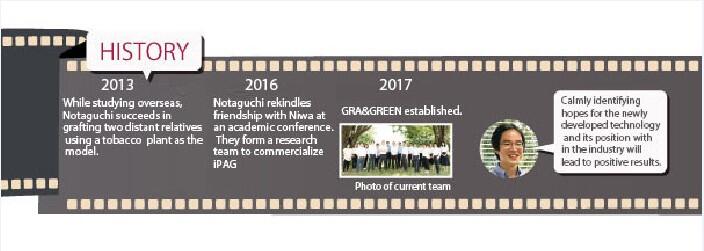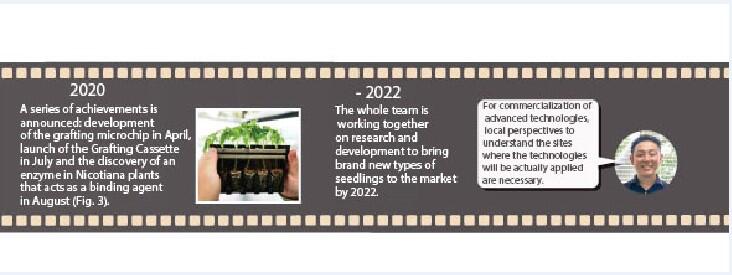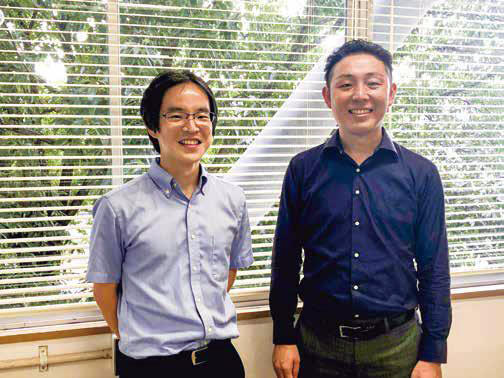
Here is a plant with roots and lower leaves from the Asteraceae family, and upper leaves and flowers from a tomato plant of the Solanaceae family. Nagoya University venture firm GRA&GREEN (Nagoya, Aichi Prefecture) is attracting attention due to a project to graft plants from different families, something hitherto thought impossible. By unleashing the undiscovered potential of plants with unique, cutting-edge technology, they are aiming to reinvent truly sustainable agriculture and food from the seed and seedling research area.
A discovery that defied common knowledge; The Nicotiana plant connects distant relations
Grafting is an agricultural technique used since ancient times. Grafting leaves and stalks from good-quality and high-yielding plants onto rootstock of plants, which are highly resistant to illness or salt damage, will result in a species that possesses the strengths of both plants combined. The practice is widespread among fruit and vegetable growers because it enables stable production, but has only been possible among closely related plants. This is because a plant rejects any graft from a plant of a different family.
Michitaka Notaguchi defied such common knowledge. He discovered in 2013 that he could graft remotely-related plants by using an intermediary of a Nicotiana species. Notaguchi says, "We were doing a graft as an experiment to verify the information transmission within the plant, such as how phenomena that occurred in the leaves would be transmitted to the roots. Trying out various plants in the lab, we accidentally succeeded in grafting Solanaceae and Brassicaceae plants using a Nicotiana benthamiana model species."
Notaguchi has named the technology used to graft plants of different families using Nicotiana plants "iPAG (Inter-family Partner-Accepting Graft)." He started the applied technology research with the aim of setting up a company, hoping to find a way that would enable the technology to be used in farming. His partner was Masaki Niwa, a younger colleague from his student days in the same lab at the Kyoto University Graduate School of Agriculture. As a youngster, Niwa dreamed of becoming a researcher with the ambition to conduct agricultural research to contribute to society. It was his first year as an assistant professor at Kyoto University, and he had just started his journey as a researcher. "Listening to Notaguchi, I decided that day that I would join his research team because it was research I was convinced would generate new value," he states confidently.
In 2015, Notaguchi's project was selected for the Program for Creating Start-ups from Advanced Research and Technology (START), which provides support for the commercialization of technology "seeds" emerging from universities and other institutions. Looking back, Notaguchi says, "For those of us researching at universities, the START was an important assistance for conducting activities such as survey analysis of market scale and characteristics required to build a commercialization plan, and it enabled us to be prepared for setting up a new business."
In 2017, the final year of the START program, Niwa and Notaguchi set up GRA&GREEN together. Initially, they planned to include an entrepreneur in the team, but they could not find anyone with the experience of commercializing cutting-edge technology in the field of agriculture. So, Niwa put his hand up instead. "If that is the case, then I will take care of the business side of it." It was his first taste of venture leadership, but he was not out of his depth at all.
Application of instant, flexible breed improvement genome editing and MEMS (Micro Electrical Mechanical System)
Against the background of a farming labor shortage, there is increasing demand for grafted seedlings that can raise productivity efficiently. "In Japan, this is a market of 500 million plants, or 10 billion plants worldwide, for a market size of 700 billion yen globally," explains Niwa. However, many grafted seedlings are produced by hand and supply is unable to keep up with demand. GRA&GREEN set two major focus points for its business development: developing technology to create new breeds, and developing a production system for grafted seedlings.
Improving breeds through artificial crossbreeding and genetic engineering takes decades of time and effort. "Applying grafting technology using existing plants can take as little as two years from planning to commercialization. If iPAG technology is put into practical use, we will be able to produce new seedlings anytime we like," says Niwa. The company is now developing genomic editing technology tools based on iPAG in order to achieve cheap variety improvement at low cost. In the grafted specimens, the team has focused on the fact that it is not just water and nutrients but also RNA that are sent from the rootstock to the grafts. The mechanism is to improve a crop to have desired traits by creating a genomic editing tool in a Nicotiana plant, sending it via a grafted plant to the target crop, and editing its genes before the target crop bears seed.
Grafting is done at the budding stage, but for tomatoes, which have a stem diameter of just two millimeters at the budding stage, it is a task that requires experience and craft of experts. Says Notaguchi, "If using Arabidopsis as the model plant, the stem diameter is around 0.2 mm at the time of budding. It is actually difficult to conduct grafting while observing with a microscope." That is why they developed a "micrografting chip" to hold the rootstock and graft in place (Fig. 1). The design is based on microfabrication technology (MEMS) and gives the grower a stable base to work on as the silicon-based microchip changes shape with the growth of the plant.
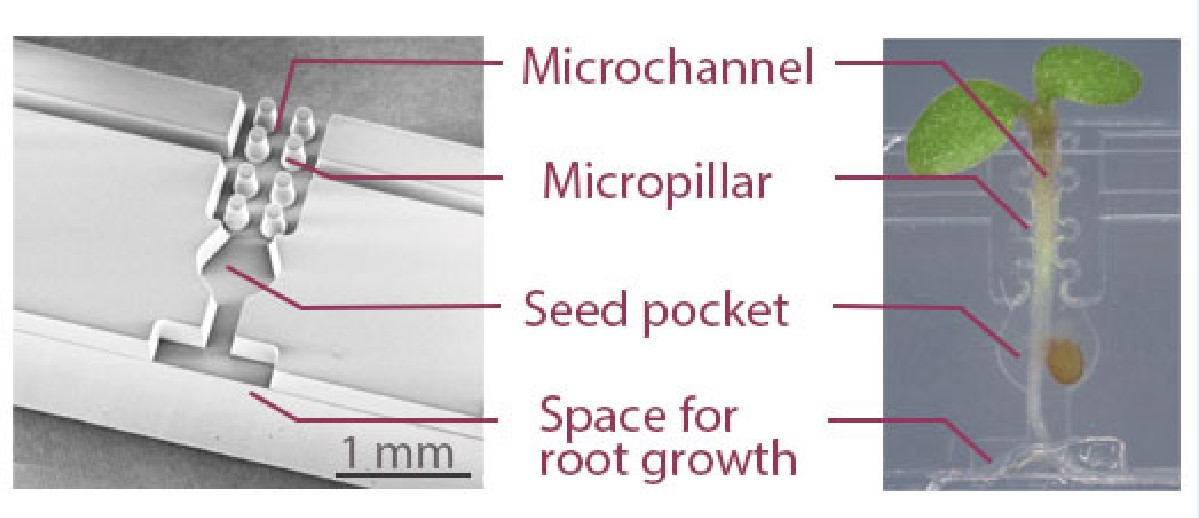
The micrografting chip was developed as a research tool. While grafting has over 2,000 years of history, its mechanism is not yet fully understood. Thus, it is hoped that the micrografting chip will aid progress on researching the grafting mechanism. Using a micrografting chip to produce grafted seedlings resulted in the Grafting Cassette, which went on sale in July 2020 (Fig. 2). By using the Grafting Cassette, even an untrained operator can produce around 250 grafted seedlings per hour. In the future, the goal is to automate grafting by integrating a grafting mechanism into the cassette, which would speed up the process eight-fold compared to the manual procedure.
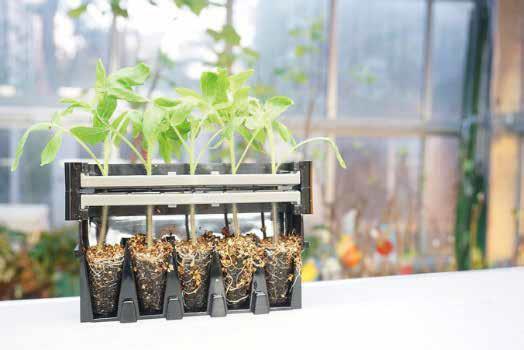
Rootstock is highly resistant to drought and salt will enable food production even in land unsuitable for agricultural use
Stable production of crops is increasingly difficult worldwide due to the changing global climate, population increase, and a reduction in arable land. Notaguchi is hopeful though, saying, "If we develop iPAG and other grafting technologies and use the rootstock of plants resistant to drought and salt, we will be able to produce food even in regions not suited to farming."
Continues Niwa, "Take highland vegetable croplands. The altitude of croplands has been rising, and the issue can no longer be resolved simply by moving these lands around. This means, we need to improve the ability of crops, by making the vegetables more heat-resistant, for example. It is this ability to rapidly adapt to dramatic environmental change where GRA&GREEN technology shines." If the quality of local vegetables, which require production costs and labor, is improved to make them easy to grow, it will lead to protecting the traditional agricultural industry and food in respective regions.
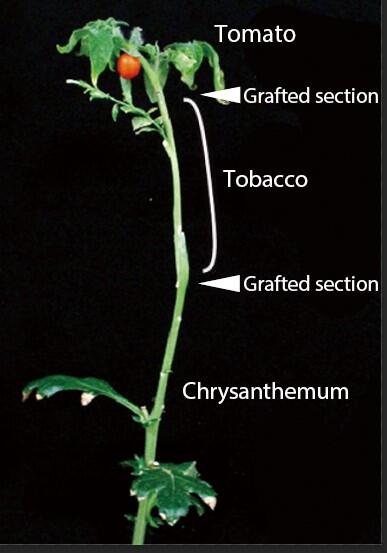
The name of the company can also be read "grand green," with the "and" linking "graft" and "green." GRA&GREEN are sketching out the new future of food and farming, starting from the original desire of the company to maximize the potential of plants to make the world a better place.
